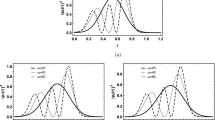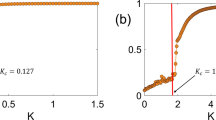Abstract
1. The sequence of the organisation levels is regarded as originating from a sequence of symmetry breakings. Each breaking generates a more improbable structure. In addition to the Euclidian symmetries, homogeneity, isotropy, translation, rotation, helix displacement, neutrality and even indiscernibility can be broken. Here are considered the initial (§ 2) and the subatomic breaking molecular morphogenesis (§ 3, 4) and other higher breakings.2.1 HOMOGENEITY BREAKING OF THE VACUUM SPACE. We studied this as a new model of wave-corpuscle relation. Every noticeable point breaks the space homogeneity. Directed by a momentum this breaking operates as a fissure.2. Postulate of the corpuscle. The quantum mechanical corpuscle is the end of a fissure, the momentum of which characterises direction and velocity.2.2. Postulate of the wave. The associate wave comes from the end of the fissure and works to split the medium.2.3. Corollary to the trajectory. The fissure prefers continuity and a straight line. Nevertheless the fissure can stop at a point and then start from an other point. This discontinuity and any momentum possible discontinuity are limited only by uncertainty relationships; frequency of discontinuity is limited by the first one. Vacuum has no memory of the fissures. 2.4.Corollary to the localisation. The fissure diminishes the medium constraints and allows the medium to vibrate in a domain surrounding the end of the fissure.2.5. Physical analogies.
-
- Photo-elastic studies of the fissuration of solids (Corten & Park, 1963) show a little sphere and a wavelike perturbation at the end of the fissure.
-
- A fragile and resonating object can be broken by a sound wave. This crack emits a sound wave. Here we consider one associated wave, emitted and absorbed.
-
- Broken panes picture an emission of rays.
li]2.6. Consequences of the fissure model (without modifying the laws of quantum mechanics).
-
A.
The corpuscle generates a fractal trajectory. From literature (Abott & Wise, 1981; Nelson, 1966) or from the present model we can calculate a fractal dimension, namely 2. But this numerical value corresponds to the simplest assumptions. Inhomogeneity or rapid changes in time could increase this value. The actual fractal dimension is a physical property which was neglected until now. It can govern the probability of collision between corpuscles, hence the probability of nuclear fusion between corpuscles, like deuton, the enhancement of which at low energies was recently discovered (Fleischman & Pons 1989).
-
B.
The difficulties linked with the extrapolation from macroscopic structure vanish. No wave is indefinitely extended. Corpuscle can disappear and reappear again (e.g. it can pass through a nodal surface). The indiscernibility is included in the model.
li]3. ATOM HYBRIDIZATION. The calculated value of the entropy (Chantelot & Laforgue, 1966) demonstrates that the hybridization is a physical phenomenon. It corresponds to the breaking of the spherical symmetry into a polyhedral symmetry. Hybridized orbitals can be a priori determined by equiprobability of the different angular momenta for the atom (which cannot be measured into a molecule). The independently determined eigenfunction enables one to find the same symmetry. li]3.1. Image of the molecule on the basis of a constituent atom. The “natural orbitals” of the molecular wave function of such a basis describe pertinently the atom symmetry breaking and the supplementary deformation by the molecular surrounding. li]3.2. The criterion of the so-called “maximum ponderated overlapping” leads to the “image orbitals”. Hence we obtain a generalization of the well known criterion of Pauling. li]3.3. Physical sense of the “image orbitals”. They describe the molecule from the point of view of the atom. They are adapted to the bonding of the atom with its molecular surrounding. li]4. THE CHIRAL BREAKNG. Referring to previous publications (Laforgue, 1983, 1988, 1989a, b, c, d, 1990) asymmetrical molecules oscillate or break depending on the height of inversion and destruction barriers. Fig. 1 pictures the domains of stability. Fig. 2 pictures the so-called “Path of Easiest Destruction and Inversion”. li]4.1. Equations of the chiral breaking. The more general case is the endothermic one (Fig. 3). Some equations are proposed. The so-called destruction time {Eq A} and inversion time {Eq B} determine by {Eq Z} process the final symmetry {Eq C} or final chirality {Eq D}. A more accurate treatment is the application of the Bohr-Heisenberg principle. If the inversion barrier is higher than the destructive one, the classical solution is confined to the right or to the left; hence the quantum behaviour is a random tunnelling and not a periodical oscillation (at low quantum numbers the amount of inversion is negligible). The results are experimentally verified because no evolution in chiral structure other than random inversion was ever observed. li]4.2. Chiral molecule is a pseudo-stationary state. Two enantiomers are distinct molecules. They do not have the symmetry of the Hamiltonian because they are not a solution of the Schrödinger's amplitude equation. li]4.3. Chiral constraint. The complete error potential is formulated. It follows an electronic oscillation and intra-molecular forces on the nuclei. In an oscillating molecule these forces affect the oscillation. The forces become permanent by chiral breaking, which explains asymmetrical properties. li]4.4. Chiral medium. A molecule submitted to asymmetrical forces has asymmetrical properties. Some of these effects have not yet been formulated but should be postulated (e.g. induced electronic circular dichroïsm). Quantum measurement theory shows that the effective inversion time increases when chiral interactions become more frequent. li]4.5. Biological role of chirality. Racemic life cannot work, hence there is optical symmetry breaking of the biosphere. It demands an initial preference and global autocatalysis, which can take the form of molecular recognition followed by defense mechanisms. The set of chiral molecules can be characterised as an intermediate level between matter and life. li]5. BREAKING OF THE CHIRAL LEVEL AND OF THE HIGHER ONES.
-
- The chain of identical chiral monomers can be submitted to an helix displacement breaking (i.e. non identical monomers) leading to a memory organisation level.
-
- If the electronic fluctuation through chemical bounding is broken, two systems of electrons become mutually discernable. That occurs on the organisation level of the super molecule.
-
- Following breakings generate spacial forms and acting mechanisms, as well known.
li]6. CONCLUSION. The reviewed breakings can be interpreted in terms of living requirements. There common cause is symmetry fragility. Matter and life derive from the vacuum space by successive spontaneous symmetry breakings. Finally, the question of an upper limit of organisation arises.
Similar content being viewed by others
References
Abott, L.F. & Wise, M.B. (1981). Dimension of a quantum-mechanical path. Am. J. Phys. 49: 37–40.
Auger, P. (1980). Coupling between N levels of observation of a system (biological or physical) resulting in creation of structures. Int. J. General Systems 6: 83–100.
Boccara, N. (1976). Symétries brisées. Paris, Hermann ed. et ref. citées.
Bouligand, Y. (1980). In: Y. Bouligand, ed. La Morphogénèse de la Biologie aux Mathématiques. Paris, Maloine: 27
Chantelot, J. & Laforgue, A. (1966). Recherches sur l'hybridation atomique. II. Notion d'hybridation pour l'atome isolé et construction de spinorbitales hybrides. J. chimie Phys. 63: 749–754.
Claverie, P. & Ions Lasinio, G. (1986). Instability of tunelling and the concept of molecular structure in quantum mechanics: the case of pyramidal molecules and the enantiomer problem. Phys. Rev. A 33: 2245.
Corlen, H.F. & Park, F.R. (1963). Fracture. Int. Sci. Technol. 15: 24–36.
Fleischman, M. & Pons, S. (1989). Electrochemically induced nuclear fusion of deuterium. J. Electroanal. Chem. 261: 301–308.Errata: Fleischman, M., Pons, S. & Hawkins, M. J. Electroanal. Chem. 263: 187–188.
Frikee, E. (1988). Unification of particles and interactions in an alternative symmetry scheme.- Hadronic J. 6: 77–136.
Giudice, E. del, Doglia, S., Milani, M. & Vitielo, G. (1983). Spontaneous symmetry breakdown and boson condensation in biology. Phys. lett. 95A: 508.
Giudice, E. del, Doglia, S., Milani, M. & Vitielo, G. (1984). A quantum field theoretical approach to the collective behaviour of biological systems. Nuclear Phys. B 251: 375.
Giudice, E. del, Doglia, S., Milani, M. & Vitielo, G. (1986). Electromagnetic field and spontaneous symmetry breaking in biological matter. Nuclear Phys. B 275: 185–199.
Giudice, E. del, Doglia, S., Milani, M. & Vitielo, G. (1988). Spontaneous symmetry breaking and electromagnetic interaction, in biological systems. Phys. Scripta 38: 505–507.
Jona-Lasinio, G. & Claverie, P. (1986). Symmetry breaking and classical behaviour. Prog. Theor. Phys. Supplement 86: 54.
Julg, A. (1989). Origin of the L-homochirality of amino-acids in the proteins of living organisms. In: Maruani, J. ed. Phys. Chem. Biol. vol. 4: 33–52. Dordrecht, Kluwer Acad. Publ.
Kizel, V.A. (1980). Optical activity and dissymmetry in living systems. Soviet Phys. Usp. 23: 277.
Koutecky, J. & Laforgue, A. (1977). Second quantization of systems with constant number of particles in the Dirac notation. Int. J. Quantum Chem. 11: 505–523.
Laforgue, A., Roux, M., Masse, J.L. (1958). Recherches sur l'hybridation atomique. I. L'hybridation atomique a-t-elle un sens physique? J. Chimie Phys 55: 189.
Laforgue, A. (1955). Diagramme des triatomes symétriques. Cahiers de Phys. 53: 1–25.
Laforgue, A. (1957a). Sur la variation de la structure électronique avec la distance interatomique. Cas de H3, H3 + rectilignes symétriques. Cahiers Phys 73: 93–112.
Laforgue, A. (1957b). La diagramme d'un systme de corpuscules identiques considéré comme grandeur. J. Chimie Phys 54: 413–420.
Laforgue, A. (1983). La chiralité de la matière vivante est-elle une conséquence de la chiralité de l'espace physique? (violation de la parity). In: H. Le Guyader, ed. Actes 2è sémin. Ecole biol. théor. Solignac 1982, p. 107–132. Rouen, Public. Univ.
Laforgue, A. (1987). Réciprocé particule-lacune et chronobiologie. In: H. Luck, ed. Solignac 1985, p. 131–146. Paris, C.N.R.S.
Laforgue, A. (1988). The chiral molecule. J. Mol. Str. (Theochem.) 166: 499–504.
Laforgue, A. (1989a). Chiralité et Biologie. In: Y. Bouligand, ed. Actes sémin. Ecole biol. théor. Solignac 1987, 3–16. Paris, C.N.R.S.
Laforgue, A. (1989b). Right-handed and left-handed molecular structures. In: J. Maruani ed. Molecules in Physics Chem. Biol. 4: 53–76. Dordrecht, Kluwer Acad. Publ.
Laforgue, A. (1989c). Les propriétés chirales de la matière vivante et la physique quantique. Ann. Fond. L. de Broglie 14: 391–425.
Laforgue, A. (1989d). The nature of the chiral breaking. Proc. IIIrd Europ. Meet. Spear. Biol. Molec. Rimini, Italy (Sept. 1989).
Laforgue, A. (1990). Sur quelques concepts fondamentaux de la chimie quantique. Cours Ecole Chim. quant. Rio de Janeiro, 1988. Rio de Janeiro, C.B.P.F.ed.
Laforgue, A. (1992, sous presse). La brísure spontanée de symétrie, concept interdisciplinaire fondamental. Paris, 1989, Congrès des Sociétés Savantes. In: La Révolution intedisciplinaire aujourd'hui. Paris, C.T.H.S. éd.: 41–48.
Laforgue, A. & Guérin, P. (1988). Complete error potential. Theor. chim. seta 74: 269–274.
Langenbeck, W. (1935). Die organischen Catalysatoren. Berlin, Springer.
Lee, J.P. & Yang, C.N. (1956). Question of parity conservation in weak interactions. Phys. Rev. 104: 254.
Mendelbrot, B. (1975). Les objets fractals. Paris, Nouvelle Bibliothèque Scientifique, Flammarion.
Mezey, P.G. (1986). Tying knots around chiral centers: chirality polynomials and conformational invariants for molecules. J. Am. Chem. Soc. 108: 3976.
Nelson, E. (1966). Derivation of the Schrödinger equation from Newtonian mechanics. Phys. rev. 150: 1079.
Norden, B. (1978). J. mol. evol. 11: 313.
Parton, V.Z. & Boriskovsky, V.G. (1989). Dynamic fracture mechanisms. Trad. R.S. Whadwa 2: 203. N.Y., Hemisph. Publ Corp.
Pasteur, L. (1874). Observations. (Séance du 1er Juin). C.R. Ac. Sci 78: 1515.
Schrödinger, E. (1951). Qu'est-ce que la vie? Trad. L. Keller. Paris, Ed. de la Paix.
Stewart, I. (1989) L'erreur de Curie. La symétrie et ses brisures. Pour la Science 143: 90.
Ulbricht, T.L.V. (1962). In: M. Florkin & B. Mason eds. Comparative biochemistry 4, Mason, Acad. Press.
Author information
Authors and Affiliations
Rights and permissions
About this article
Cite this article
Laforgue, A. Brisures de symetrie hierarchisant les niveaux d'organisation. Acta Biotheor 40, 221–235 (1992). https://doi.org/10.1007/BF00168150
Published:
Issue Date:
DOI: https://doi.org/10.1007/BF00168150




